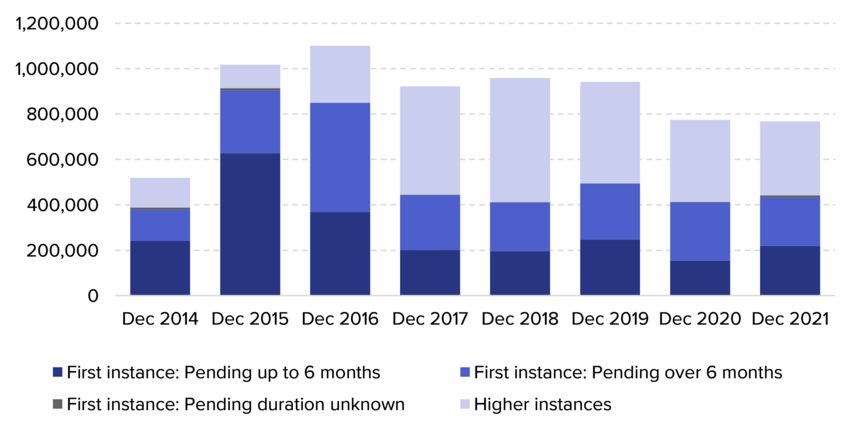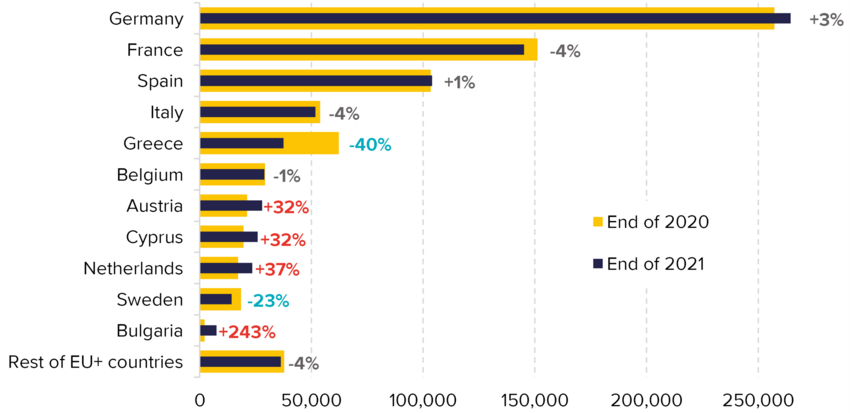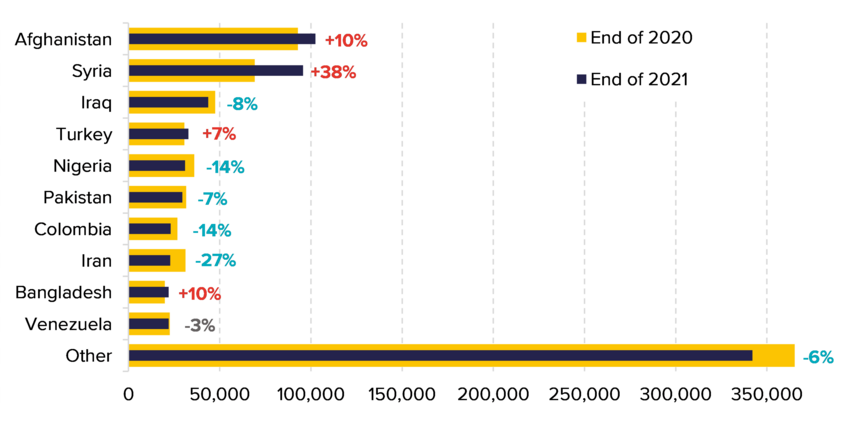
Section 4.6. Pending cases
Once an application for international protection has been lodged with a national authority, the processing phase begins. The final outcome of this process is a decision at first instance, which can be appealed and followed by another decision. The examination of a case can also be closed for other reasons, including an explicit withdrawal initiated by the applicant, an implicit withdrawal, for example in the case of absconding, and an acceptance of responsibility by a partner country in the context of a Dublin procedure.
While an application is under examination, it is part of the stock of pending cases. Pending cases are a key indicator reflecting the workload experienced by national authorities and the pressure on national asylum systems, including reception systems.
At the end of 2021, over 767,000 applications were awaiting a decision in EU+ countries,xl similar to a year earlier with a slight 1% decrease. This comparison hides important variations throughout the year. In the first months of 2021, the stock of pending cases gradually declined, but the number started to quickly increase in August 2021 to return on par with the level at the end of 2020 in just a few months. Hence, the stock of pending cases was still higher than in the pre-crisis level in 2014 (see Figure 4.19), adding pressure on national reception systems
More cases pending at first instance than at higher instances
Figure 4.19. Pending cases in EU+ countries at the end of each year, 2014-2021

When combining Eurostat data with EUAA EPS data,xli, xlii the number of cases pending at first instance and at second or higher instances can be disaggregated. EUAA EPS data allow to further analyse pending cases by a duration of 6 months or longer at first instance.
The results indicate that the overall stock of pending cases increased at first instance, whereas there was a decrease at higher instances. The annual total of pending cases was influenced by two opposing trends: while cases pending at first instance rose (in the second half of 2021), cases at higher instances decreased steadily. At the end of 2021, some 442,000 cases were pending at first instance, accounting for 58% of the total – a higher share than a year earlier.
About one-third (34%) of all pending cases at all instances continued to be awaiting a decision in Germany, with a total of 264,000 open files (see Figure 4.20). This was driven particularly by more cases by Syrian and, to a lesser extent, Afghan applicants. Other EU+ countries with a considerable number of pending cases included France (145,000), Spain (104,000), Italy (52,000) and Greece (38,000). Compared to the end of 2020, Greece managed to decrease its backlog substantially (-40%), whereas decreases in France and Italy were more modest (-4% each).
In some countries, there were sharp increases in the number of pending cases: Austria (+6,700), the Netherlands (+6,400), Cyprus (+6,300) and Bulgaria (+5,400). In each of these countries, the number of pending cases started to rise in the second half of 2021. While in Cyprus the increase affected multiple nationalities, in Austria and the Netherlands it affected primarily Syrian applicants, and in Bulgaria Afghans and Syrians.
Most cases awaiting a decision were still in Germany, France and Spain
Figure 4.20. Pending cases in EU+ countries at the end of 2021 compared to the end of 2020

Afghans (103,000) and Syrians (96,000) not only continued to have the most pending cases in EU+ countries at the end of 2021, but their numbers rose, by 10% and 38%, respectively, compared to 2020 (see Figure 4.21). For Afghans, the total represented the most pending cases since July 2020. The increases for both nationalities were driven by the fact that more applications were lodged in 2021, thus by the end of the year, over two-thirds of cases awaiting a decision for Afghan and Syrian applicants were pending at first instance.
At the end of 2021, nationals of Iraq, Turkey, Nigeria, Pakistan, Colombia, Iran, Venezuela and Bangladesh (in descending order) also had considerable stocks of pending cases, although much lower than for the top two citizenships. Among them, increases compared to a year earlier were recorded only for Turks and Bangladeshis, whereas the stocks decreased markedly for Iranians, Nigerians, Colombians, Iraqis and Pakistanis.
Most applications for the bulk of the top nationalities were pending in Germany, where the backlog for Afghan and Syrian cases rose considerably compared to 2020. Colombians and Venezuelans had the most pending cases in Spain, Pakistanis in Italy and France, and Bangladeshis in France and Italy. Notable increases of caseloads for Afghan applicants were seen also in Bulgaria, Belgium and Italy. Pending cases for Syrian applicants grew in Austria, the Netherlands and on a smaller scale in Bulgaria and Cyprus.
Over two-thirds of pending cases at the end of 2021 continued to comprise male applicants. For almost all nationalities, more males were awaiting a decision than females. The exception was for Latin Americans, such as Colombians and Venezuelans, where the majority of pending case were for women.
While 55% of pending cases were for adult males, children accounted for close to one-quarter (23%) of all applicants awaiting a decision. This affected somewhat more boys than girls in this group. Syrians and Afghans jointly accounted for over one-third of all minors. In total, 76% of all minors who had yet to learn the outcome of their application for international protection were below 14 years of age.
Rising number of pending cases for Afghan and Syrian applicants
Figure 4.21. Pending cases in EU+ countries at the end of 2021 compared to the end of 2020 by Top 10 countries of origin of applicants for international protection

Source: Eurostat [migr_asypenctzm] as of 15 March 2022.
___
Footnotes
xl At the time of writing, data were missing for Lithuania.
xli EUAA data cover first instance cases. They are provisional and not validated, but they provide information on overall trends at the EU+ level.
xlii EUAA EPS data do not include information on Iceland and Liechtenstein. According to Eurostat data, the total number of pending cases in these two countries was low.

